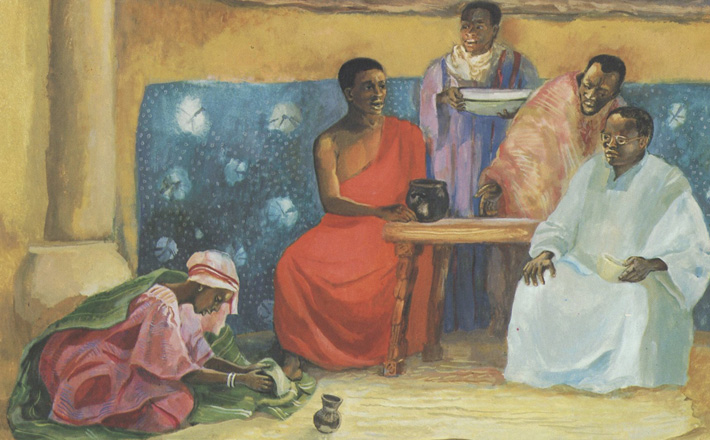Commentary on Luke 7:36-8:3
It is often noted that Luke, more than the other Gospel writers, highlights portrayals of women.
From the start, Luke portrays Mary, Elizabeth, and Anna as courageous women who follow God’s plan and whose voices praise God’s arriving redemption in Jesus. It is also the case that Luke often pairs a story of a woman alongside a story of a man. For example, the healing of a centurion’s slave is paired with the raising of a widow’s son (7:1-17); and Jesus tells twin parables of a woman losing a coin and a man losing a sheep (15:4-10).
In the lectionary text for this week, women who follow Jesus in discipleship are introduced to Luke’s reader in parallel fashion to his introduction of the Twelve (male) disciples (8:1-3; 6:12-16). In fact, in 8:1-3, Mary Magdalene, Joanna, Susanna, “and many [women]” are described in the same way as the Twelve — they are “with him” as Jesus proclaims the good news of God’s reign. This is a discipleship characteristic that identifies both male and female followers of Jesus in Luke. In Luke 10, Jesus sends out seventy of his followers in mission to prepare for his kingdom message (10:1), and, from a narrative perspective, Luke’s readers would be expecting this larger group to include the women mentioned in 8:1-3. Mary Magdalene and Joanna are mentioned again in 24:8-10, there as the first witnesses to Jesus’ resurrection.
So while the Twelve are the most prominent disciples in Luke’s narrative, he accents the role of women in Jesus’ ministry in important ways. In 8:3, Luke indicates that women were crucial to financial support of Jesus’ ministry. And in Jesus’ first-century context, it would have been ideal to have both men and women disciples who could attend and minister to men and women (respectively) in the crowds coming to Jesus.
The portrait of female disciples of Jesus from 8:1-3 provides an interesting counterpart to the account of the woman who anoints Jesus in a meal scene at the end of Luke 7 (7:36-50). In that passage, the discipleship of a woman who receives forgiveness from Jesus is on display. And Luke portrays her gratitude to Jesus as exemplary for his reader.
The setting is a dinner held by Simon, a Pharisee (7:36, 40). An unnamed woman enters Simon’s house, and, although uninvited, begins to anoint Jesus’ feet with perfume and wash them with her tears. Luke identifies her as a woman known in that city to be a sinner (J. B. Green, The Gospel of Luke). This descriptor ties her to the accusation leveled at Jesus in the immediate context: “Look, a glutton and a drunkard, a friend of tax collectors and sinners” (7:34). It seems that this woman knows of Jesus’ reputation and has likely even experienced his ministry. Her gratitude exhibited by the actions of weeping and kissing Jesus’ feet point in this direction (7:38).
In his Gospel, Luke highlights Jesus’ concern for sinners like this woman. Peter has responded to Jesus’ miraculous provision of fish by exclaiming, “Go away from me, Lord, for I am a sinful man!” (5:8; see 18:13). And when Pharisees and scribes complain that Jesus is eating with tax collectors and sinners, Jesus responds that he has come to call sinners to repentance (5:30-32; see 19:7). In 15:2, the Pharisees will again bemoan that Jesus “welcomes sinners and eats with them.”
In a Jewish context, the descriptor “sinner” would indicate someone who was not faithful to God’s law — a transgressor of the Torah. Luke does not specify the sin of Peter or the other sinners with whom Jesus eats. Yet in this passage of the woman who anoints Jesus, it is commonplace for commentators to assume that she is a prostitute, as if the only sin a Jewish woman of the first century could commit would be sexual sin. Given that Luke can specify that particular sin (see 15:30), his less explicit reference here to this woman “who was a sinner” should not be pressed further but should be heard in concert with the other references to sinners in Luke as recipients of Jesus’ kingdom ministry.
Central to this passage is the portrayal of the woman as one who demonstrates trust in and love for Jesus, again presumably as a recipient of his merciful ministry to “tax collectors and sinners.” Jesus tells a brief parable to Simon to illustrate that those who have had a great debt cancelled will love more than those who have only a small debt forgiven (7:40-43). Then he applies his parable to the woman who has welcomed him as a lavish host would welcome a most honored guest. While some of the actions that Jesus mentions as signs of welcome (7:44-46) go above and beyond what might be expected in first-century hospitality (e.g., anointing a guest’s head with oil is not a required sign of hospitality), the point is that the woman in her actions has provided lavish hospitality because of her great love for Jesus and his mercy.
The story concludes with Jesus’ declaration that her sins are forgiven, which causes the other guests to wonder who is this Jesus who can even forgive sins. At the heart of it, Luke’s message is Christological. This passage highlights Jesus’ power to forgive sins and pronounce salvation for this woman who comes to him in faith to show her love for him (“Your faith has saved you”).
Luke 7:36-8:3 provides an opportunity to preach about some of the courageous women who come to Jesus in faith to follow and serve him. For Luke, they provide paradigms for ways his own audience should respond to Jesus. And they can function this way for our own audiences, as we commend to them the discipleship qualities of faith, service, and following Jesus by being “with him.” And for the center of our preaching, Luke provides a compelling portrait of Jesus, the Messiah who forgives, saves, and restores.


June 16, 2013